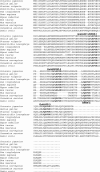The control of reproductive physiology and behavior by gonadotropin-inhibitory hormone
- PMID: 20607134
- PMCID: PMC2895338
- DOI: 10.1093/icb/icn019
The control of reproductive physiology and behavior by gonadotropin-inhibitory hormone
Abstract
Gonadotropin-releasing hormone (GnRH) controls the reproductive physiology and behavior of vertebrates by stimulating synthesis and release of gonadotropin from the pituitary gland. In 2000, another hypothalamic neuropeptide, gonadotropin-inhibitory hormone (GnIH), was discovered in quail and found to be an inhibiting factor for gonadotropin release. GnIH homologs are present in the brains of vertebrates, including birds, mammals, amphibians, and fish. These peptides, categorized as RF amide-related peptides (RFRPs), possess a characteristic LPXRF-amide (X = L or Q) motif at their C-termini. GnIH/RFRP precursor mRNA encodes a polypeptide that is possibly cleaved into three mature peptides in birds and two in mammals. The names of these peptides are GnIH, GnIH-related peptide-1 (GnIH-RP-1) and GnIH-RP-2 in birds, and RFRP-1 and RFRP-3 in mammals. GnIH/RFRP is synthesized in neurons of the paraventricular nucleus of the hypothalamus in birds and the dorsomedial hypothalamic area in mammals. GnIH neurons project to the median eminence, thus providing a functional neuroanatomical infrastructure to regulate anterior pituitary function. In quail, GnIH inhibits gonadal activity by decreasing synthesis and release of gonadotropin. The widespread distribution of GnIH/RFRP immunoreactive fibers in all animals tested suggests various actions within the brain. In accordance, GnIH/RFRP receptor mRNA is also expressed widely in the brain and the pituitary. GnIH/RFRP immunoreactive axon terminals are in probable contact with GnRH neurons in birds and mammals, and we recently demonstrated expression of GnIH receptor mRNA in GnRH-I and GnRH-II neurons in European starlings. Thus, GnIH/RFRP may also inhibit gonadotropin synthesis and release by inhibiting GnRH neurons in addition to having direct actions on the pituitary gland. Intracerebroventricular administration of GnIH/RFRP further inhibits reproductive behaviors in songbirds and rodents, possibly via direct actions on the GnRH system. The expression of GnIH/RFRP is regulated by melatonin which is an internal indicator of day length in vertebrates. Stress stimuli also regulate the expression of GnIH/RFRP in songbirds and rodents. Accordingly, GnIH/RFRP may serve as a transducer of environmental information and social interactions into endogenous physiology and behavior of the animal. Recently, it was shown that GnIH/RFRP and its receptor are also expressed in the gonads of birds, rodents and primates. In sum, the existing data suggest that GnIH/RFRP is an important mediator of reproductive function acting at the level of the brain, pituitary, and the gonad in birds and mammals.
Figures




Similar articles
-
Gonadotropin-inhibitory hormone action in the brain and pituitary.Front Endocrinol (Lausanne). 2012 Nov 28;3:148. doi: 10.3389/fendo.2012.00148. eCollection 2012. Front Endocrinol (Lausanne). 2012. PMID: 23233850 Free PMC article.
-
Gonadotropin-inhibitory hormone neurons interact directly with gonadotropin-releasing hormone-I and -II neurons in European starling brain.Endocrinology. 2008 Jan;149(1):268-78. doi: 10.1210/en.2007-0983. Epub 2007 Sep 27. Endocrinology. 2008. PMID: 17901228
-
Central and direct regulation of testicular activity by gonadotropin-inhibitory hormone and its receptor.Front Endocrinol (Lausanne). 2014 Jan 27;5:8. doi: 10.3389/fendo.2014.00008. eCollection 2014. Front Endocrinol (Lausanne). 2014. PMID: 24478760 Free PMC article. Review.
-
Physiology, Gonadotropin Inhibitor.2022 Sep 26. In: StatPearls [Internet]. Treasure Island (FL): StatPearls Publishing; 2025 Jan–. 2022 Sep 26. In: StatPearls [Internet]. Treasure Island (FL): StatPearls Publishing; 2025 Jan–. PMID: 31536257 Free Books & Documents.
-
Gonadotropin-inhibitory hormone (GnIH), GnIH receptor and cell signaling.Gen Comp Endocrinol. 2013 Sep 1;190:10-7. doi: 10.1016/j.ygcen.2013.02.030. Epub 2013 Mar 15. Gen Comp Endocrinol. 2013. PMID: 23499786 Review.
Cited by
-
Phenology, seasonal timing and circannual rhythms: towards a unified framework.Philos Trans R Soc Lond B Biol Sci. 2010 Oct 12;365(1555):3113-27. doi: 10.1098/rstb.2010.0111. Philos Trans R Soc Lond B Biol Sci. 2010. PMID: 20819807 Free PMC article. Review.
-
Structural and functional divergence of gonadotropin-inhibitory hormone from jawless fish to mammals.Front Endocrinol (Lausanne). 2014 Oct 24;5:177. doi: 10.3389/fendo.2014.00177. eCollection 2014. Front Endocrinol (Lausanne). 2014. PMID: 25386165 Free PMC article. Review.
-
Gonadotropin-inhibitory hormone (GnIH): discovery, progress and prospect.Gen Comp Endocrinol. 2012 Jul 1;177(3):305-14. doi: 10.1016/j.ygcen.2012.02.013. Epub 2012 Feb 26. Gen Comp Endocrinol. 2012. PMID: 22391238 Free PMC article. Review.
-
Analysis on DNA sequence of goat RFRP gene and its possible association with average daily sunshine duration.Mol Biol Rep. 2012 Sep;39(9):9167-77. doi: 10.1007/s11033-012-1789-3. Epub 2012 Jun 26. Mol Biol Rep. 2012. PMID: 22733487
-
The Role of Arginine-Phenylalanine-Amide-Related Peptides in Mammalian Reproduction.Int J Fertil Steril. 2015 Oct-Dec;9(3):268-76. doi: 10.22074/ijfs.2015.4540. Epub 2015 Oct 31. Int J Fertil Steril. 2015. PMID: 26644848 Free PMC article. Review.
References
-
- Bahk JY, Hyun JS, Chung SH, Lee H, Kim MO, Lee BH, Choi WS. Stage-specific identification of the expression of GnRH mRNA and localization of the GnRH receptor in mature rat and adult human testis. J Urol. 1995;154:1958–1961. - PubMed
-
- Barnett DK, Bunnell TM, Millar RP, Abbott DH. Gonadotropin-releasing hormone II stimulates female sexual behavior in marmoset monkeys. Endocrinology. 2006;147:615–623. - PubMed
-
- Bentley GE, Jensen JP, Kaur GJ, Wacker DW, Tsutsui K, Wingfield JC. Rapid inhibition of female sexual behavior by gonadotropin-inhibitory hormone (GnIH) Horm Behav. 2006;49:550–555. - PubMed
-
- Bentley GE, Perfito N, Ukena K, Tsutsui K, Wingfield JC. Gonadotropin-inhibitory peptide in song sparrows (Melospiza melodia) in different reproductive conditions, and in house sparrows (Passer domesticus) relative to chicken-gonadotropin-releasing hormone. J Neuroendocrinol. 2003;15:794–802. - PubMed
-
- Bentley GE, Ubuka T, McGuire NL, Chowdhury VS, Morita Y, Yano T, Hasunuma I, Binns M, Wingfield JC, Tsutsui K. Gonadotropin-inhibitory hormone and its receptor in the avian reproductive system. Gen Comp Endocrinol. 2008;156:34–43. - PubMed
LinkOut - more resources
Full Text Sources

